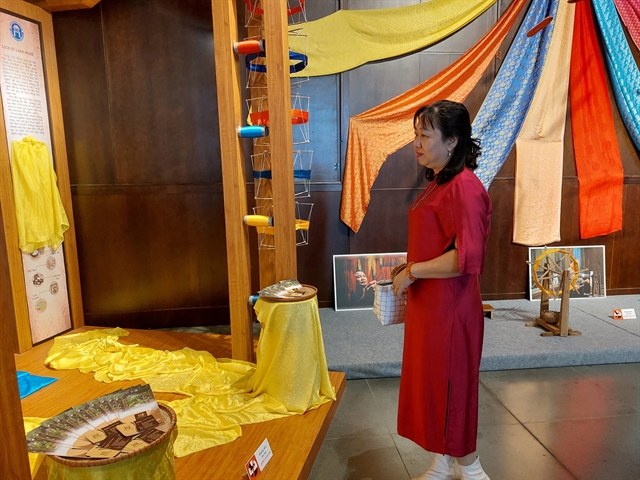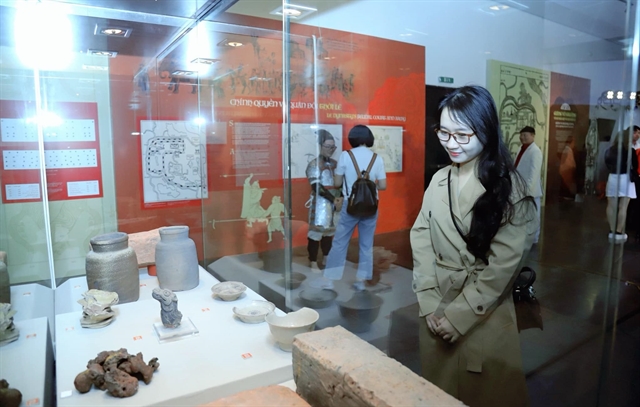 Life & Style
Life & Style

“By organising these specialised exhibitions, the Hanoi Museum not only showcases its role as a prominent cultural creative space in the capital city Hà Nội but also realises its commitments and initiatives to integrate creative activities into all aspects of life,” said Director of the Hanoi Museum, Nguyễn Tiến Đà

|
| A space dedicated to Vạn Phúc silk weaving village. VNA/VNS Photo Đinh Thuận |
HÀ NỘI A series of exhibitions honouring the cultural heritage values of Hà Nội have been opened at the Hanoi Museum, as part of the events celebrating Vietnam Cultural Heritage Day on November 23.
The exhibitions include The Giảng Võ School and the Collection of Weapons from the Lê Dynasty, The History of Earth's Formation through a Collection of Fossil Artefacts, and The Essence of Vietnamese Traditional Crafts through the Perspective of Contemporary Interior Design.
The first exhibition introduces over 200 artefacts, images and documents about Giảng Võ School, the first national martial arts school of ancient Thăng Long Imperial Citadel, and the collection of Ngọc Khánh weapons that have been recognised as national treasures.
Through the architectural artefacts made of ceramics and wood excavated at the location, it can be affirmed that this is a large-scale construction of a national martial arts school during the Lê Dynasty, spanning from the 15th to the 18th century.

|
| A visitor is seen at The Giảng Võ School and the Collection of Weapons from the Lê Dynasty exhibition at the Hanoi Museum. Photo courtesy of Hanoi Museum |
The exhibition The Essence of Vietnamese Traditional Crafts through the Perspective of Contemporary Interior Design aims to honour the traditional handicraft villages of Hà Nội, connect tourism and commerce, and promote creative design activities.
Ten typical craft villages of Hà Nội are introduced within the space, including Định Công silver casting village, Khoái Nội embroidery village, Phú Vinh bamboo and rattan weaving village, Nhân Hiền sculpture village, Chuôn Ngọ mother-of-pearl inlay village, Thiết Úng fine wood carving village, Thụy Ứng horn comb village, Bát Tràng pottery village, Vạn Phúc silk village and Hàng Trống folk painting village.
From the creative perspective of students from nine universities in Việt Nam and another from Thailand, the exhibited products bring forth an innovative and unique art space.
For the first time, the Hanoi Museum has collaborated with the Hanoi Fossil Museum to launch a joint exhibition. The History of Earth's Formation through a Collection of Fossil Artefacts revolves around the intersection of science, history, nature, and art, allowing visitors to experience film footage, appreciate paintings, and particularly, examine fossil specimens dating back hundreds of millions of years.
The exhibition is divided into several sections like a collection of fossil specimens depicting the evolution of living organisms, including animal and plant fossils from up to 530 million years ago, the collection of fossil specimens from the prehistoric era, or a collection of fossil specimens, tools and models that depict the evolution of human species.
In addition to the exhibited fossil artefacts, the Hanoi Fossil Museum has also designed a 3D Mapping space that depicts the history of Earth's formation adopting 3D virtual reality technology.
“By organising these specialised exhibitions, the Hanoi Museum not only showcases its role as a prominent cultural creative space in the capital city Hà Nội but also realises its commitments and initiatives to integrate creative activities into all aspects of life,” said Director of the Hanoi Museum, Nguyễn Tiến Đà. VNS




